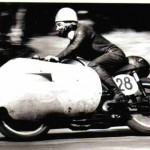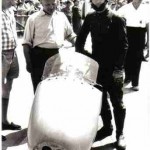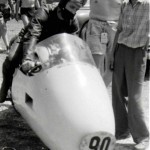Roger Barker: The Man Who Charmed A Town
Australian motorcycle enthusiasts usually don’t need a second invitation to visit a pub. So if you’re planning a trip to Germany, consider the Hotel Luginsland. It’s in the pretty German village of the same name, 300km due north of Munich.
Why this particular pub? It has an entire wall dedicated to an Australian motorcycle racer. His name was Roger Barker and he died 53 years ago, a few hundred metres from the hotel’s front door, while racing on the 7.6km Schleiz public road circuit.
Roger Barker had been in the Schleiz less than a week. But in that time he had created such an impression that 2000 people attended his funeral.
Barker was a member of Australia’s 1957 Isle of Man TT team. He had been on Continental Circus for less than a season and contested some half a dozen international race meetings.
Yet half a century later, he was remembered with tributes at the Schleizer-Dreieckrennen road-races and in a German classic-bike magazine.
How is this so? The answer lays in a combination of Roger Barker the man, the fact that Schleiz was behind the Iron Curtain in East Germany and the manner of his death.
Barker had just turned 30 when he debuted at the Isle of Man in June 1957. The jobs he’d held reflected his outgoing personality — radio announcer, taxi driver, sales representative and motorcycle salesman. He was a little guy who knew how to walk into a room and make an impression, beginning with a repertoire of jokes and sight gags.
Barker’s racing career been just as varied, beginning in his home town of Mudgee on dirt and moving to Victoria because it had the biggest domestic road-racing scene in the mid 1950s. He won the Victorian 350 TT in January 1956 on a Norton.
The Isle of Man TT saw Barker tenth in the 500 race. He backed that up with a pair of eighth places in the Dutch TT – in the days when world championship points only went down to sixth.
After Assen, the Australian riders headed separate ways. The three with works rides headed to Spa-Francorchamps for the Belgian GP. Barker and some of other private entrants took advantage of markedly better start-money offers to go to Schleiz.
Roger qualified on pole position for the 350 race. However, race day was blazing hot. Forty degrees and Roger was never comfortable in serious heat. Moreover, in 1957 sports people didn’t know about hydration as they do today.
Both Barker’s races would last more than an hour. It would not be pleasant in black leathers. Nonetheless, Roger led from the start of the 350 race, setting a new outright lap record before retiring with tyre trouble.
In the 500 race, Roger led once again – chased by Germany’s Ernst Hiller on a BMW.
But midway through the scheduled 20 laps and on the opposite side of the course from the start/finish, the conditions proved too much. Roger Barker collapsed, falling from his machine in a straight line. He struck a lone apple tree at the side of the circuit and was killed instantly.
Roger’ devastated family wanted his body brought home. However, Schleiz had no facilities for keeping it. So the locals organised a huge funeral and buried Roger Barker in the grounds of the Hilltop Church. Three weeks later the family’s wishes were honoured when Roger’s body was flown home and reburied in the Melbourne suburb of Heidelberg.
In 1995, five years after German reunification, Aub Barker was finally able to visit Schleiz. Looking at the church yard, he said in hindsight it was a pity the family did not leave his younger brother buried there — because it was a beautiful setting, in a town where he was loved.
Footnote: If you do make it to Luginsland, there are major race meetings throughout the season on the modified Schleizer Dreieck circuit — including rounds of the German Superbike championship and Sidecar World Cup, and a Classic GP.



